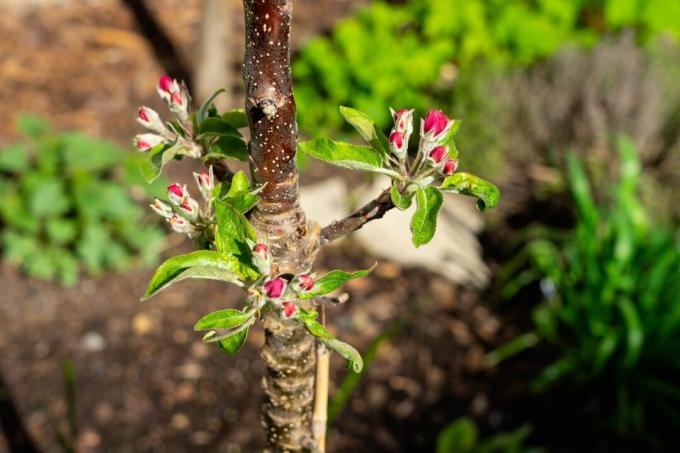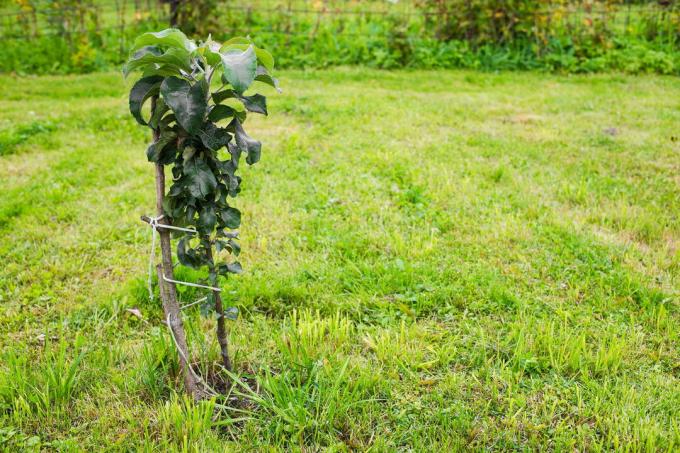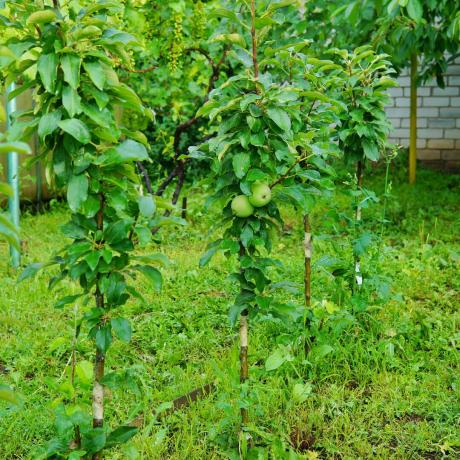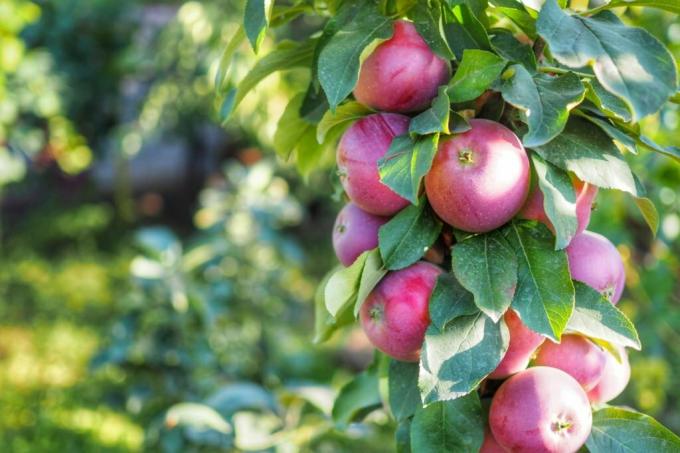Do you want a fruit tree in your garden, but don't have enough space? We have the solution and show you how to properly plant a columnar fruit tree.

The size of the garden plays an important role in the choice of plants. There are few fruit trees that are naturally short. However, some common types of fruit are grown to save space. In small gardens, for example, half-stems, spindle trees or trellis fruit find a place. Real columnar fruit, in turn, has genetically defined varietal characteristics that lead to very narrow growth with few side shoots. So that you can soon harvest your own fruit, in this article we explain what you need to consider when planting columnar fruit.
contents
- Buy columnar fruit: This is what you need to pay attention to
-
Popular columnar fruit varieties
- Pillar apple: The best varieties
- Columnar pears: The best varieties
- Pillar plum: The best varieties
- Pillar cherry: The best varieties
- The right season for planting columnar fruit
-
Grow columnar fruit in pots and containers
- Growing columnar fruit: this is what you need
- The right location for columnar fruit
- Guide to columnar fruit planting
- Plant columnar fruit in the bed
- Caring for columnar fruit after planting
- Cut columnar fruit
Real columnar fruit are special varieties whose requirements can differ from those of normal fruit trees. What you should consider when buying columnar fruit, which types of fruit are available and how best to proceed when planting, we have summarized for you below.
Buy columnar fruit: This is what you need to pay attention to
In order not to have to do without your own fruit even in a confined space, the planting of columnar fruit is very suitable. For example, different types of apples (penalty), pears (Pyrus) and plums (Prunus domestica). However, keep in mind that due to the small surface area, the yields will of course be lower than with large fruit trees. In addition, you should definitely inquire in advance whether the desired variety is self-pollinating or whether a certain type of fruit has to be planted in the immediate vicinity as a pollinator. If you don't have enough space for overwintering potted plants, you should also make sure that the chosen variety is hardy.
A basic distinction is made between genetically created columnar trees and cultivated columnar fruit. The former grow slender by themselves and have only low demands on the cut and care. Cultivated columnar fruit, on the other hand, often grows very tall and requires regular topiary. Unfortunately, fruit trees that grow normally are also sold as columnar fruit again and again. You should be careful here, because these trees usually quickly lose their shape. That's why we recommend that you only buy columnar fruit from specialist shops, where good quality and authenticity of variety are important.

Popular columnar fruit varieties
Columnar fruit trees are specially bred varieties with so-called columnar growth. The selection of slim, space-saving fruit varieties is therefore of course limited. Real column fruit can therefore only be spoken of in the case of a few apple and pear varieties. In the following, we will also introduce you to some types of stone fruit that can be grown as columnar fruit with regular pruning.
Pillar apple: The best varieties
Just because you have a small garden doesn't mean you have to go without fresh apples. Below we present the most popular columnar apple varieties:
- 'Equilibro': Large, half-red colored fruits; sweet and sour taste; very compact growth; mildew and scab resistant
- ,Flamenco': Hardy, high-yielding variety; green-red fruits with an intense taste; Harvest from September; ready to eat from October; only conditionally storable
- 'greencat': Robust, easy-care variety; green, firm fruits; harvest in September; resistant to scab, powdery mildew and aphids; storable until December
- 'Malini Black Beauty': Dark red, juicy fruits; can grow up to three meters high; good scab resistance; must be trimmed regularly
- 'redcat': Hardy variety; yellow-green, firm fruits; high resistance to scab, powdery mildew and aphids; ripening time from mid-September; good storage ability
- 'Redini Cuckoo': Red-flowered and red-fleshed columnar apple; sour fresh taste; high tolerance to scab; Harvest from mid-September; ready to eat from October
- ,Rhapsody': Hardy variety; medium-sized, cone-shaped fruits; very juicy; ready to pick in September; long shelf life
- ,Rondo': Large spherical fruits; sweet and sour taste; very juicy; yellowish pulp; ripe in September
- 'Starcat': Similar to the variety 'Elstar‘; particularly robust against mildew, scab and aphids
- ,Sonata': Medium-sized fruits with whitish flesh; sweet taste; Harvest from early September
Columnar pears: The best varieties
Normally, pear trees take up a lot of space in the garden. We show small columnar pear varieties that are also suitable for balconies and terraces:
- 'condo': Medium-sized fruit with a sweet taste; high-yielding autumn variety (ripening period September to October); good fruit quality
- 'decor': Remains naturally narrow; juicy fruits with a sweet taste; bright red color; ripens in late September; Fruits can be stored until mid-December
- ,Obelisk': Good winter pear; juicy, white flesh; medium growth
- 'Sapphire': Easy-care columnar pear; ready for harvest in September; green-yellow fruits with a sweet taste; bountiful yields
- 'Starkrimson': Medium-sized fruit with a sweet taste; melting, juicy pulp; high-yielding autumn variety (harvest from September to October)

Pillar plum: The best varieties
Even if there are actually no real columnar plum varieties, you can still use small, slender varieties:
- 'Fruca': Easy-care plum variety; slender tree; dark blue stoneless fruits; juicy, yellow flesh
- 'Fruttini Skyscraper': Medium-sized, juicy fruits with a very good aroma; columnar, pyramidal growth; Harvest between late July and mid-August; strong growth; can grow up to four meters high
- 'Fruttini Sunscraper': Large, yellow-orange plums; very juicy, yellow flesh; Harvest from mid to late September; only partially self-fertile
- 'imperial': Robust plum variety; blue fruits with yellow flesh; good stone dissolving; self-pollinating; late harvest
- ,Top': Late plum variety; self-fertile; steel-blue, rounded fruits; golden yellow, juicy flesh; very productive; Harvest from mid-September
Pillar cherry: The best varieties
The cherry is also not one of the classic high-stem fruits. But the following short-growing varieties are in no way inferior to them:
- Prunus cerasus'Jachim': self-fertile sour cherry; is still one of the true columnar trees; slim growth; bears on one- and two-year-old wood; very easy to care for; mid-late harvest (mid-July)
- Prunus avium'Sylvia': Sweet cherry variety; large, dark brown fruits; extremely slim and compact growth; harvest in July; self-pollinating
- Prunus avium'Sara': Sweet cherry variety; upright, slender growth; large, short-stemmed fruits with a very good taste; Fruits are bursting
- Prunus avium'Queen Mary': Sweet cherry variety with beautiful flowers; large, bright red fruits; self-pollinating; grows about two and a half meters high
- Prunus avium'victoria': Self-fertile sweet cherry; medium-sized, soft-fleshed fruits; sweet, aromatic taste; Harvest from early to mid-July
Attractive, space-saving columnar kiwis (Actinidia arguta), plum plums (Prunus domestica subsp. syriaca), columnar nectarines (Prunus nucipersica) and columnar apricots (Prunus armeniaca). Furthermore, various berries such as gooseberries (Ribes uva crispa) or currants (Ribes rubrum) as columnar fruit.

The right season for planting columnar fruit
Fruit trees are often planted in autumn (October to November), so they can grow well over the winter. However, columnar fruit is usually offered as a container plant and can basically be planted all year round. Alternatively, you can also plant in spring (March to April) when severe frosts are no longer to be expected.
Grow columnar fruit in pots and containers
The newer varieties of columnar fruit in particular are very well suited for cultivation in buckets on the balcony or terrace. In the following, we will explain to you how best to proceed when planting.
Growing columnar fruit: this is what you need
The following utensils should be ready for planting a columnar tree:
- planter (min. 30 liters)
- Fresh plant and compost soil
- shovel, watering can
- Possibly. mainly organic long-term fertilizer
The right location for columnar fruit
A spot in full sun to part shade is ideal for your columnar fruit tree. However, make sure that the sapling is protected from strong winds and rain. So that your little tree gets through the winter well, winter hardiness is also crucial for choosing the right location. Because only hardy columnar fruit can remain in the pot on the balcony or terrace all year round.
Guide to columnar fruit planting
So that the tree is sufficiently supplied with nutrients and can grow stably, the planter should be selected large enough. Then the tree only has to be repotted every four to six years and the old substrate replaced with fresh one. A young columnar tree needs a bucket with at least 30 liters capacity. A drainage hole on the underside of the pot ensures that excess water can drain off and waterlogging is avoided.
It is best to plant the tree immediately after purchase. Columnar fruit requires loose, nutrient-rich substrate. It is therefore best to fill the bucket with a mixture Organic universal soil and compost. If necessary, you can also work some fertilizer in granular form into the soil. It is best to use a primarily organic long-term fertilizer such as our Plantura Organic universal fertilizer, this provides your columnar tree with enough nutrients in the long term. Then insert the tree in such a way that the grafting point is still a few centimeters above the ground. Then water the freshly planted tree well. Slurrying ensures that the soil settles well in the planting hole and encloses the roots.
Due to their special growth form, columnar fruit trees can set special accents in the garden as solitary plants. For example, they can also be planted as a natural room divider, as a privacy screen for property lines or to hide unsightly objects (water butts, compost heaps). However, it is essential to keep a planting distance of 50 to 60 centimeters between the individual plants so that there is no competition for nutrients between the trees. Mixed planting with different flowering and harvest times is also very attractive. Also varieties with different fruit colors, for example apples, are a special eye-catcher.

Plant columnar fruit in the bed
However, not all columnar fruit trees are suitable for planting outdoors. On the one hand, some varieties are only partially hardy, on the other hand, some types of fruit may fall back into their original growth form after planting. Pillar cherries, for example, can grow into a stately tall tree in a very short time, which can reach a height of up to five meters under optimal growth conditions. Depending on the thickness of the base, it may also be necessary to fasten the tree to a support post in the bed. In the case of heat-loving columnar nectarines and columnar apricots, winter protection made of fleece or a temporary move to winter quarters may be necessary to protect them from frost are.
Summary of planting columnar fruit:
- A bright, sheltered location is important
- Select a sufficiently large planter
- Fill with a mixture of garden and compost soil
- If necessary, incorporate a long-term fertilizer
- Don't plant the tree too deep
- Soak well after planting
- Pay attention to sufficient planting distance in the bed
- Not all varieties are suitable for outdoor use
Caring for columnar fruit after planting
In the first few years after planting, young fruit trees should always be supplied with sufficient water without sinking into waterlogging. The used soil in the pot should also be refilled regularly. Support annual fertilization in spring with compost or a predominantly organic slow-release fertilizer In addition, the growth and development of your columnar tree is optimal, so that you can soon harvest the first fruits be able. In pot culture, you can fertilize again in June for fruit formation. As you at Fertilizing fruit trees We explain the best way to proceed in a special article.
But be sure to keep an eye on the fruit setting of the tree and, if necessary, thin out at the beginning of June. If the fruit set is too rich, the fruit will be small and the tree will be drained in the long run. In the worst case, it can happen that there is no yield at all in the next year (so-called alternation). Therefore, only leave one or two fruits per fruit cluster and break out excess fruit buds.
For overwintering outdoors, we recommend protecting potted plants from garden fleece or bamboo mats, which are wrapped around the trunk and the pot. In addition, you can cover the surface of the earth with straw or leaves. If you want to overwinter the columnar fruit indoors, you should choose a bright and frost-free room (e.g. basement, stairwell, conservatory) as a temporary location. After the last frost, you can move the columnar fruit back outside in spring.

Cut columnar fruit
In most cases, real columnar fruit does not require regular pruning. Cultivated columnar apples usually have a slender growth habit by nature and develop their flowers and fruits directly on the trunk. Cultivated columnar fruit, on the other hand, must be pruned regularly to maintain its shape. To do this, shorten all shoots of pome fruit to around 20 centimeters and stone fruit to around 40 to 50 centimeters in length. The best time for pruning is from November to February. Older fruit branches that have already been removed are cut back to a stub after a few years to encourage the growth of new shoots. In height, columnar fruit should only be pruned from the third or fourth year. To do this, cut the center drive back to the desired height.
As Pruning fruit trees properly, we explain in detail in our special article.


